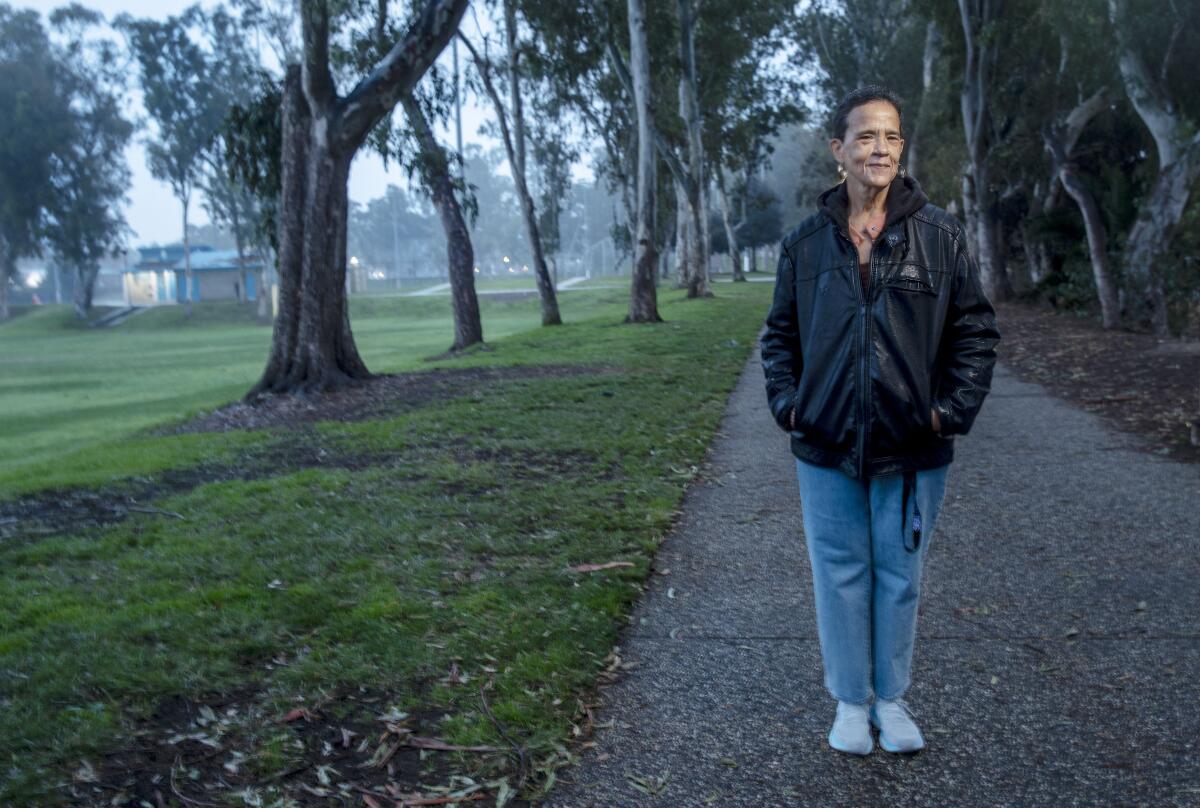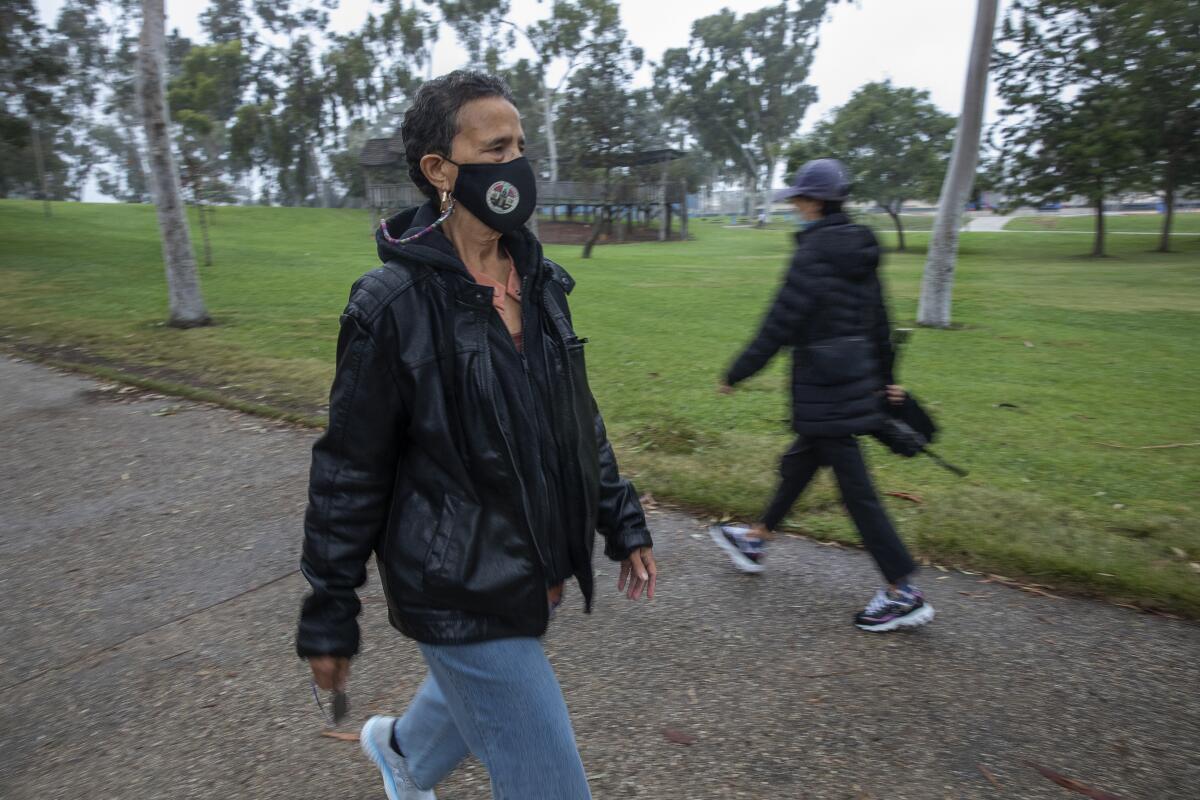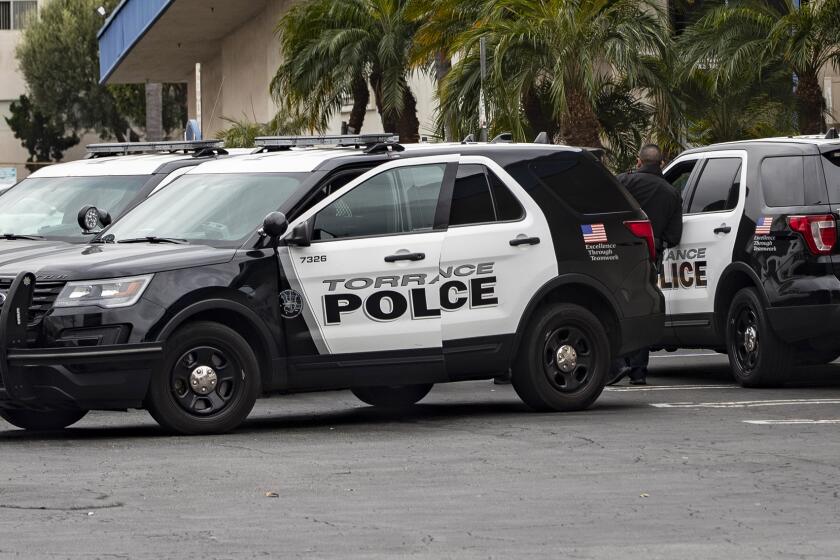Torrance police bigotry scandal echoes the early days of L.A. race discrimination

- Share via
Revelations of an ugly battery of bigoted texts by members of the Torrance Police Department came as no surprise to local resident Joan Marks.
Why not?
“Because I’m a minority,” said Marks, offering that as one of several reasons she wasn’t shocked by my colleague James Queally’s bombshell story about years of vile texts by a dozen or more Torrance officers who took aim at Black people, Jews and members of the LGBTQ community.
“It’s very upsetting,” said Marks, a retiree who worked for many years in children’s social services. “I can’t stereotype the whole city. We have some nice people in Torrance. But I don’t trust the Police Department and would be leery about calling them.”
Marks told me that when she wears a hooded shirt, she doesn’t use the hood, just to make sure she’s not profiled as a threat to public safety. But she added that bigotry extends well beyond the borders of Torrance.
“It’s national,” said Marks, whom I met while she strolled Charles H. Wilson Park, where in the summer of 2020 an Asian woman was verbally assaulted by someone telling her to go back where she came from.
Marks, who is well-versed in local history, threaded the current scandal back to the darkest days of the past, when powerful civic leaders in Torrance and other places in California conspired to keep their towns and cities mostly white.

“We know all about restrictive covenants,” Marks said.
That was a tool first used early in the 1900s by city planners and powerful members of the Southern California real estate industry, who dictated where home shoppers could and could not buy.
The Times has identified a dozen Torrance police officers who are under investigation for sharing racist and homophobic text messages and images.
Los Angeles did not invent the practice, but because the city was rapidly expanding, it perfected the tricks and tools of segregation, which remains largely in place a century later here and elsewhere. The long shadow of bigotry has not lifted either. And in Torrance, which is mostly white and Asian, only about 3% of the population is Black.
“Torrance was a place where you couldn’t get approval for a subdivision without restrictive race covenants,” says Gene Slater, author of “Freedom to Discriminate: How Realtors Conspired to Segregate Housing and Divide America.”
Slater said Southern California communities including Torrance proudly promoted “permanent race restrictions” for the benefit of “the working man.” These pioneering tactics, he argued, were copied in ways that helped segregate the entire country.
Andrea Gibbons, author of “City of Segregation,” said one prominent South Bay developer discriminated against Black buyers in Dominguez Hills and Torrance. When the practice was protested during the civil rights movement, Gibbons said, “his response was to build a new development in Compton” and tell Black buyers that was where they had to go.
It wasn’t just that Black people couldn’t buy homes in certain cities. They weren’t even welcome as visitors. Mystery writer Gary Phillips, a friend of Gibbons’, said that he “just knew as a teenager coming up in South Central in the ‘70s, if I had to go to Torrance, best be out of Dodge by sundown. Same went for places like Glendale.”
Gibbons sees remnants of this “us versus them” sentiment in the creation of gated communities and in the operating psyche of many law enforcement officers.
In the 1990s, a federal investigation into discriminatory hiring practices in Torrance revealed evidence of systemic racial profiling. As Queally reported, former officers said they were instructed to stop and question Black motorists without cause and were told that while some Black people were “upstanding,” others were best described by a slur.
The more recent scandal began earlier this year, when two Torrance police officers were charged with spray-painting a swastika inside a vehicle. A review of that case led to the discovery of multiple officers sharing vile texts. One of the cops in question was charged in August with shooting an unarmed man in the back. Two others were involved in the shooting death of a Black man suspected of driving a stolen vehicle.
In the texts, officers joked about gassing Jews and assaulting gays. Black people were referred to as savages or variations of the N-word. One officer said he was out to “make Torrance great again,” echoing former President Trump. Another text depicts a photo of former President Reagan feeding a monkey, and the caption says Reagan used to babysit former President Obama.
The Torrance Police Department, state attorney general’s office and district attorney’s office are all involved in ongoing investigations. Dozens of criminal prosecutions in which the officers were involved have already been thrown out thanks to evidence of bias. Hundreds more could follow.
On my travels through Torrance the other day, I stopped by the Police Department to see if I could talk to Chief Jay Hart, a Torrance native and 20-year member of the force. He got the top job in June, and is seen in some quarters as a good bet to straighten out the department.
“I am committed to accountability, and I will not tolerate any form of bigotry, racism, hate or misconduct,” the chief said when news of the scandal broke.
Hart was unavailable when I visited. If in the future I do sit down with him, I’d like to ask what reforms he has in mind and how widespread racist attitudes might be. I’d also like to know whether he and others who have been a part of the institution for many years were aware of the rot that existed, and if so, why they kept quiet.
“Breaking the blue wall of silence is the only way to regain the public’s trust,” Torrance science teacher Jay Estabrook wrote in a letter to The Times, saying other officers “have to have the integrity and fortitude” to speak up about officers whose transgressions could cost taxpayers millions in “excessive force and wrongful arrest claims.”
Estabrook, a longtime local resident and youth sports coach, told me those officers don’t represent the Torrance he knows. He said he knows Chief Hart personally and considers him “open-minded” and “a straight shooter,” and he has faith that Hart will root out haters.
A U.S. Department of Justice lawsuit filed against Torrance Police in the 1990s uncovered claims that officers routinely used racial slurs and even had code phrases for when they saw Black people in the city.
“Those officers interact with my children and with kids that I coach, and my students,” Estabrook said. “I wouldn’t really want those officers to have any connection to the kids in my life.”
Torrance is not the place it was in the days when housing discrimination was codified. In the last presidential election, about 60% of the Torrance vote went to President Biden.
When Biden won, Marks noted, it wasn’t the first time Trump challenged the legitimacy of an elected president. He was the one who doggedly kept up the lie that the first Black president of the United States was born in Africa.
“Trump made it OK to come out,” Marks said of the great redneck liberation. “I’m still concerned about the [millions] who didn’t go away, and still support him.”
Some of whom may be wearing badges.
“I’m not anti-police, because we need them,” said Marks, but for her, this story is one more example of the continued need for police reform.
As for “making Torrance great again,” to borrow a certain officer’s phrase, let the campaign begin with the summary dismissal of officers who have shamed themselves, tainted the badge and the institution, and let down the entire community.
More to Read
Sign up for Essential California
The most important California stories and recommendations in your inbox every morning.
You may occasionally receive promotional content from the Los Angeles Times.















